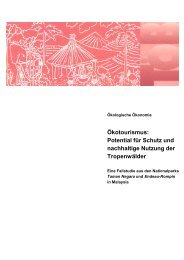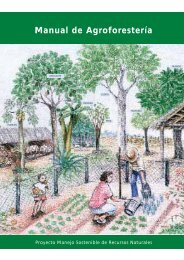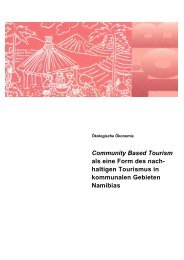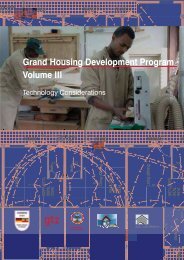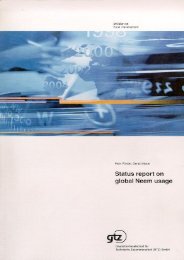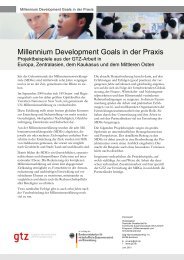urban poverty in bangladesh - Gtz
urban poverty in bangladesh - Gtz
urban poverty in bangladesh - Gtz
- No tags were found...
You also want an ePaper? Increase the reach of your titles
YUMPU automatically turns print PDFs into web optimized ePapers that Google loves.
For many of the <strong>urban</strong> citizens <strong>in</strong> Bangladesh,people liv<strong>in</strong>g <strong>in</strong> slums arenearly an <strong>in</strong>visible phenomenon. Thecommon presumption amongst thesecitizens is that slum dwellers only resident<strong>in</strong> the slums for a limited periodof time and are permanently engaged<strong>in</strong> the rural agricultural sector. Consider<strong>in</strong>gthe dense liv<strong>in</strong>g conditions <strong>in</strong>most of Bangladesh’ cities and hugeslum areas, I have been wonder<strong>in</strong>gwhether this image reflects the realityof the <strong>urban</strong> poor. Thus, I visited oneof the biggest slums <strong>in</strong> Jamalpur, <strong>in</strong> thenorth of Bangladesh. The slum whichis known as Sarpur comprises of about300 households. The hous<strong>in</strong>g structureof the small shanty homes <strong>in</strong> this slumis similar to those of other slums <strong>in</strong>other develop<strong>in</strong>g regions. Despite itsstatus as a ‘slum’, the area gives methe impression of be<strong>in</strong>g a fairly brightand green neighborhood, with littlegardens, open places here and there,and small lakes that are surroundedby palm trees. Like many other slums,this slum is already an established partof the city. The <strong>in</strong>habitants of Sarpurhave lived there for more than four tofive decades, and no longer have anyl<strong>in</strong>kages to the orig<strong>in</strong>al agriculturebus<strong>in</strong>esses of their grandfathers.The ma<strong>in</strong> reason why the first migrantscame to the slum was the lackof agricultural land ownership, dueto hereditary partition<strong>in</strong>g or land losscaused by flood<strong>in</strong>g. Work<strong>in</strong>g for otherlandowners does generally not providesufficient <strong>in</strong>come to susta<strong>in</strong> a familyon a long-term basis. Thus contrary tothe common belief, the people of thisslum established a permanent liv<strong>in</strong>genvironment and social networksaround their area, which permit themto follow their occupation and to earna liv<strong>in</strong>g.I met an elderly lady, Panmuti, <strong>in</strong> asari, cook<strong>in</strong>g <strong>in</strong> front of her house.Panmuti is about 60 years old andcame to the slum with her parentswhen she was a girl. At that stage,her family had a low <strong>in</strong>come, result<strong>in</strong>gfrom their occupation as basket carriers,beggars and other m<strong>in</strong>or roles.Panmuti got married to another youngman liv<strong>in</strong>g <strong>in</strong> the same area, who obta<strong>in</strong>eda job as a grave digger work<strong>in</strong>gfor the whole town. Together they raisedfive daughters and one son. Herson and two of her divorced daughtersare still liv<strong>in</strong>g with her. Her house hastwo rooms and is located nearby thelake. Her handicapped son uses oneroom, while she shares the other roomwith her two adult daughters and theirchildren. Both women work as domesticassistants <strong>in</strong> different households<strong>in</strong> the town. With their comb<strong>in</strong>ed <strong>in</strong>come,they can easily survive and susta<strong>in</strong>the family.The elderly lady seemed very surprisedwhen I asked her if she ever wanted togo back to her village. She said “No,what would I do there? We don’t haveany land for agriculture, so how wouldwe live there?”. Even the adolescentgirls who gathered around us, alongwith other <strong>in</strong>terested neighbors, said,they would rather stay <strong>in</strong> Sarpur thango<strong>in</strong>g back to rural areas, and wouldnot even consider return<strong>in</strong>g for marriageoffers. Many of the girls around uswere well educated, attend<strong>in</strong>g higherclasses of the local secondary school,and had basic knowledge of English.One th<strong>in</strong>g is subject to common agreement:None of the residents wants tomove back to rural areas and changethe opportunities which the city offersthem for a life <strong>in</strong> a village where theyhave no <strong>in</strong>come. Accord<strong>in</strong>g to Panmuti,people here have adapted to the life <strong>in</strong>their neighborhood. Most of them havenot been back to their orig<strong>in</strong>al village41



